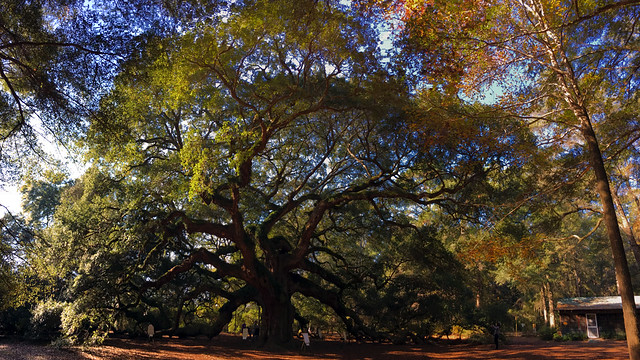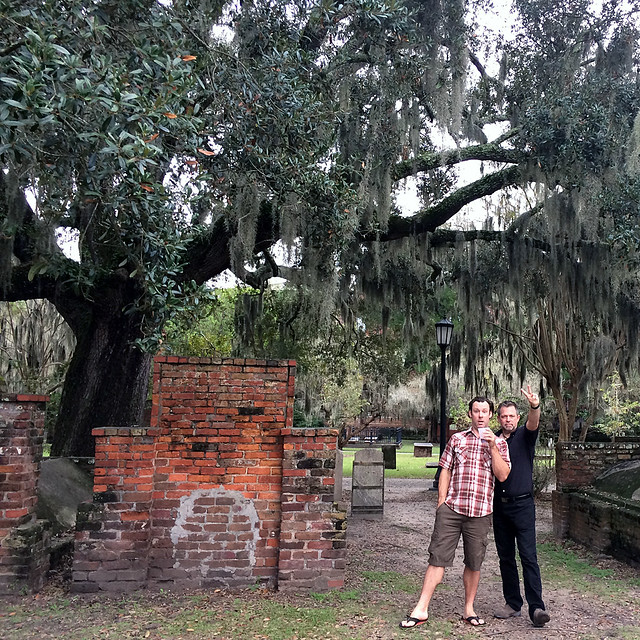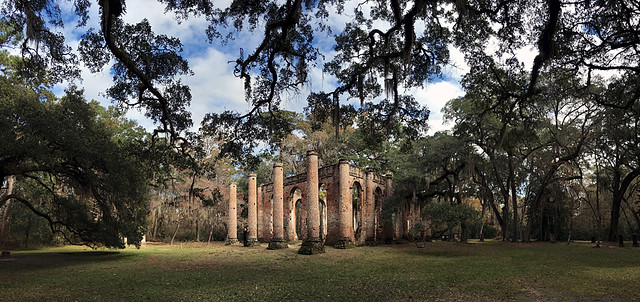Although Kim and I have paused our cross-country roadtrip to winter in Savannah, we haven’t stopped exploring the U.S. While in the South, we want to do our best to learn about the region. Plus, we’ve scheduled upcoming trips to New York City and southern Florida.
Most of our trips are close to “home”. We’ve darted down to Orlando a couple of times (a five-hour drive) to visit friends, but that’s about the farthest we want to drive. (That means Atlanta is within reach should we decide to visit.) For the most part, we’re trying to stay within two or three hours of Savannah. That’s okay. There are a couple of great cities nearby.
In fact, you can create a worthwhile roadtrip by starting in Charleston, South Carolina and working your way down to St. Augustine, Florida. We didn’t do this all in one go, but we’ve seen this stretch in pieces during the past couple of months. Let me tell you about it.
Charleston
Two hours north of Savannah is Charleston — a sister city of sorts. Charleston was founded in 1670 by English colonists. Today it features stately old homes, plentiful shopping, and lots of restaurants. Plus, there’s plenty to do nearby.
I spent far too much time researching where to stay in Charleston. A lot of the downtown hotels are expensive because they put you in the heart of the city. At first, I thought it’d be best to save money by staying on the outskirts, but then I realized parking is costly too. In the end, I opted to book two nights at The Governor’s House Inn, a bed and breakfast (with free parking) in the former governor’s mansion. It wasn’t cheap, but it didn’t blow our budget either. Plus, the place was amazing. The rooms (and the entire house) are gorgeous, and nearly everything we wanted to see was within walking distance.
![This old manions was gorgeous! [Christmas at the Governor's House]](https://farm2.staticflickr.com/1464/23876769133_b43d9c01ec_z.jpg)
We loved the Governor’s House. We’d stay there again.
While in Charleston, Kim and I spent most our afternoons and evenings walking King Street and Meeting Street. This historic downtown area is less charming than it probably once was; it’s become a massive outdoor shopping center with stores like Victoria’s Secret and Anthropologie on every corner. But there are also plenty of amazing restaurants all over the place too, and that’s what we were after. Turns out Charleston has the best food scene we’ve encountered since leaving Portland. (We still think our hometown has the best restaurants in the U.S. We’re biased!)
As always, we asked locals for their recommendations. We couldn’t try every place, of course, but we did visit:
- The Rooftop at the Vendue, a standard bar at the top of a hotel. The food and drinks were meh, but the sunset view of the city was stunning.
- Burwell’s, which had delicious drinks and an interesting (and tasty!) meat presentation. Your server brings you raw meat and a hot stone. You cook your own food. Sounds odd, but it was awesome.
- Husk, a trendy place with a companion bar next door. This place is crowded, so get there early (or make reservations). Husk’s upscale southern food was yummy, but the service was iffy.
While afternoons and evenings were devoted to food and drink, our mornings were spent visiting sites outside the city. We drove out to see the famous Angel Oak, for example:

The massive Angel Oak is a Charleston landmark.
We spent three hours exploring Middleton Place, a former plantation (and home to the oldest landscaped gardens in the U.S.). We paid to take a tour of the grounds by horse and carriage, which added to the experience. (We actually wanted to visit the well-preserved Drayton Hall but balked at the price.)
On a previous visit to Charleston, we’d already driven through Sullivan’s Island and Isle of Palms (not much to see). We also enjoyed a short morning at Folly Beach, south of town, where we had a great breakfast at the Lost Dog Cafe.
![The mill pond at Middleton Place [Middleton Place]](https://farm2.staticflickr.com/1630/24477378906_3e8a4bf2b0_z.jpg)
Except for the alligator, we thought the mill pond at Middleton was beautiful.
Savannah
Savannah isn’t quite as old as Charleston. It was founded in 1733 (also by English settlers). What sets it apart, however, is that most of the historic buildings survived General Sherman’s march to the sea during the Civil War. (Or, as people call it down here, the War Between the States.)
During our time in Savannah, we haven’t played tourist as much as you might expect. Yes, we’ve done some — and I’ll get to those experiences in a moment — but mostly Kim and I have been focused on work. That’s a good thing. But at the same time, we need to be sure we visit a few more places before we leave here at the end of March.
Most of our touring was done at the beginning of November, when Kim’s brother Doug flew out to visit for a couple of days. While he was here, we took a walking tour of Savannah’s historic downtown, strolled the beaches of Tybee Island, boarded a riverboat, and sampled some of Savannah’s restaurants. (Savannah’s food scene isn’t on par with Charleston but it’s still very good compared to most of the U.S.)

Doing the tourist thing with Kim’s brother, Doug.
Kim and I agree that the walking tour of downtown Savannah was the highlight of Doug’s visit. (The tour was free, but everyone tipped the guide, of course.) The walking tour allowed us to get up-close and personal with some of the city’s most interesting buildings and stories. Plus, the slower pace allowed our group to ask about the things that interested us most.
![Walking around old town Savannah is fun! [Savannah Walking Tour]](https://farm2.staticflickr.com/1456/24421204671_4ce7e225a2_z.jpg)
It’s easy and fun to tour downtown Savannah by foot…
The riverboat cruise was less exciting. Savannah’s waterfront just isn’t that big (or interesting). Plus, this is one of the country’s largest working ports, so there’s mostly commercial traffic along the river, which means lots of factories and warehouses, etc. Don’t get me wrong. The tour was fun, but it seemed expensive for what we got. (This has been a common theme on our trip: Boat tours don’t offer much bang for the buck. The one notable exception is the river-based Chicago architecture tour, which was awesome.)
As you wander downtown Savannah, there are plenty of restaurants to sample. Some of our favorites include:
- Rocks on the Roof, a rooftop bar similar to the one we visited in Charleston (but with more seating). Again, the food and drinks aren’t great but the views of the river and downtown are worth the visit.
- Jazz’d, a basement tapas bar with live jazz and blues. Kim and I have been here twice, and we’ll be back. The food and drinks are good and reasonably priced.
- Treylor Park, a kitschy bar that serves fancified white-trash food like peanut butter and jelly wings, chicken pancake tacos, sloppy joes, and bacon brownies. We loved the food here — but then all three of us had a good buzz on by the time we sat down.
- The Olde Pink House is a Savannah landmark, a sprawling restaurant in an old pink mansion. The food is good, no question, but the prices are high because this is such a popular place with tourists.
One place we have not tried yet is Mrs. Wilke’s Dining Room, which serves southern food family-style. It’s only open for lunch on weekdays, which makes it tough for us to get to. Plus, rumor has it the place has lines. Locals love it just as much as visitors.
The interesting thing about Savannah is the city isn’t just the city. The downtown is what most visitors come for, but there’s plenty more besides. Because this is one of the oldest colonized areas in the country, you can drive in any direction and come to someplace interesting.
Kim and I live on Whitemarsh Island, which is midway between downtown and another popular location, Tybee Island. Tybee offers sandy beaches and a funky vibe. (Locals talk about “Tybee time”, which is fluid and flexible. They also point out that the place has a reputation as a part spot — as much for the residents as the tourists.) To us, this beach isn’t much — but neither was the beach in Atlantic City. Maybe we’re spoiled by the beaches on the West Coast?
![To be honest, Pulaski isn't that exciting... [Fort Pulaski]](https://farm2.staticflickr.com/1560/23875396964_15f45157e4_z.jpg)
Between downtown and Tybee is Fort Pulaski National Monument
That said, we do have some favorite restaurants on Tybee. In fact, we’ve begun doing more date nights there than in town.
The very first place we ate in Savannah was Sundae Cafe, and it’s still one of of our favorites. The bartender is awesome. The same folks run 80 East Gastropub, which isn’t quite as good (although I’m fond of the buffalo chicken mac and cheese). I think our favorite, though, is the Tybee Island Fish Camp, a tiny place (six tables and a bar!) with rich, delicious foods and terrific drinks. (Will, the bartender, recently won the bartending competition at the Savannah Food & Wine Festival.)
St. Augustine
The final city on our tour is also the smallest. And the oldest. In fact, St. Augustine is the oldest continuously inhabited European settlement in the United States. (Yes, that’s a lot of qualifications. That’s because other sites in Virginia and New Mexico claim slightly different “oldest” bragging rights.) St. Augustine was founded by the Spanish in 1565. There’s a lot of history to explore in this town.
The best way to get a feel for the place is to buy a pass for one of the several trolley rides that wind through the narrow streets. The tour guides point out landmarks and talk about the town’s history. When you’ve finished the loop, you can go back and explore the sites that piqued your interest.
We were fortunate to spend one evening with Allie O, who publishes Simply St. Augustine, a blog designed to help visitors make the most of their trip. She and her husband know all of the best places to eat and drink and visit.
For instance, we never would have known about Odd Birds if Allie hadn’t showed us. This tiny hole-in-the-wall bar offers craft cocktails and small bites. It’s a tight fit, but well worth a short wait. Allie also introduced us to The Floridian, a local favorite.
On our own, Kim and I found The Tini Martini Bar, which doesn’t get great reviews. We liked it, however, especially our bartender. The only place in town where we’ve eaten twice is Taberna del Caballo. Again, this place doesn’t get good reviews (they’re awful, in fact), but we found the staff friendly, the food good, and the atmosphere very much like a Spanish inn.
![Unsurprisingly, my favorite part was the sample tasting... [St. Augustine Distillery]](https://farm2.staticflickr.com/1597/24477378766_bacf3685ca_z.jpg)
Touring the distillery. Ready for samples!
We didn’t just eat food while we were in St. Augustine. We also drank! We joined our friends Toni and David for a tour of the St. Augustine Distillery, which recently set up shop in the city’s old ice house. The tour was fun, the samples fine, and the food in the restaurant upstairs delicious.
It’s important to note that St. Augustine is very touristy. It’s packed with people like us, even in the winter. That means prices for lodging are high, especially near the historic downtown area. Kim and I found a fun solution. When we stay in St. Augustine, which we’ve already done twice, we opt to stay a few miles north of town at the Magic Beach Motel. This motel is quaint (and reeks of bleach) but it’s cheap. Because we spend so much on food when we’re in town, a cheap place to stay is the best option.
![We like this quaint motel [Magic Beach Motel]](https://farm2.staticflickr.com/1531/24503580225_0931a70d1a_z.jpg)
The Magic Beach Motel isn’t for everyone, but it’s perfect for us.
Final Thoughts
As with many cities, it’s the downtowns in these old settlements that hold the most charm. Outside the historic city centers, you could be anywhere in Middle America. (Well, anywhere in the South, I guess. The Spanish moss hanging from the trees is unique to this region, as is the predominance of brick buildings and the racial diversity.)
Locals in Charleston and Savannah aren’t that fond of the downtown areas because they’re crowded with tourists. (St. Augustine, especially, feels like one giant tourist trap. A fun tourist trap, but still a tourist trap.) Natives find it frustrating, so they don’t venture into the city center except for work, food, and beer. I get it. But for visitors, these three cities offer a peek at this country’s history, a vibrant restaurant scene, and architecture you can’t find anywhere else.

The ruins of the Old Sheldon Church between Charleston and Savannah.
Based on what I know now, I think a fantastic 10-14 day itinerary could be built around Charleston, Savannah, and St. Augustine. Here’s how I’d do it:
- Days 1-3: Fly into Charleston. Spend two nights exploring the area, including evenings dining downtown. Rent a car.
- Days 3-5: Drive to Beaufort via Highway 17, stopping along the way to visit the church ruins and other points of interest. Spend two nights, using this as a base to explore Hilton Head Island.
- Days 5-8: Make the short drive to Savannah, where you’ll spend three nights. Wander downtown. Visit Tybee Island for an afternoon and have dinner at one of its great restaurants.
- Days 8-10: Slowly make your way down Highway 17, entering the marshes, swamps, and sloughs of Georgia’s Sea Islands. Take time to explore St. Simons Island and Jekyll Island.
- Days 10-12: Bypass Jacksonville for St. Augustine. (Use either Highway 17 or I-95, as you see fit.) Spend two nights here. See the city by trolley. There’s lots to see and do. And eat.
- Days 12-13: Finally, scoot down to Kennedy Space Center, about 120 miles south of St. Augustine. (Kim and I haven’t done this yet; we’ll visit the Space Coast when we drive back from Miami in March.)
- Days 13-14: Zip back to Charleston and spend one last night enjoying the city.
During our time on the road, Kim and I have designed a handful of great roadtrips that we’d happily recommend to others. This is one of them. It’s an excellent way to see the Old South and get a taste for what the culture is like here. Interested in making this journey? Want more info? Ask!
{ 6 comments… read them below or add one }
Great post. I would love to take an in depth trip to this region …. I have already passed through St. Augustine on the way to the Florida Keys but didn’t make it above the Floridian state line. I would love to read more of your travel itineraries!
Thanks for this blog. We are attending a wedding in Early October in Tampa. After 2 nights in Ybor City (Tampa), we have a trip mapped out to St. Augustine Beach, Savannah, then Charleston, flying back to Arizona from Charleston. 2 nights in each stop. I appreciated your “normal” reviews and look forward to checking out some of your restaurant suggestions. We have found that as corny as the on/off buses look, they provide a great way to learn a city, then go back to what looked appealing. You mentioned Chicago, and the architectural boat tour was the best, and the on/off bus gave us a great orientation to the City, due to great tour guides
thanks again,
regards,
Kevin
Thank you so much for your interesting, informative post. My sister and I would like to visit Saint Augustine and hopefully make it up to Savannah and/or Charleston. Living in the Mojave Desert in California (she’s in rural Kansas) I am tired of driving hours to get anyplace. Anyone have recommendations for avoiding renting a car?
Witch of the 3 cities if you could only visit one for a day would you choose?
I was looking for someone that drove from Charleston to St. Augustine . Thank you for your experience, and sharing your pictures. I will go talk to the hubby soon and see if we can make a similar trip this summer since we just moved to Georgia. I can’t wait to read about your other trips.
Take care
Judy Brown
We have reservations to be at the Savannah Oaks RV park March 7 – 12. I have read your article on your road trip from Charleston, Savannah to St. Augustine. Great piece. We have 4 days to explore. What would be your recommendations to see in that length of time?